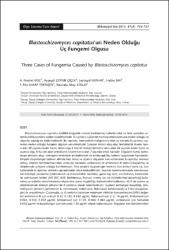| dc.contributor.author | Koç, Ayşe Nedret | |
| dc.contributor.author | Çopur Çiçek, Ayşegül | |
| dc.contributor.author | Kaynar, Leylagül | |
| dc.contributor.author | Sav, Hafize | |
| dc.contributor.author | Kasap Tekinsen, F. Filiz | |
| dc.contributor.author | Atalay, Mustafa Altay | |
| dc.date.accessioned | 2020-12-19T20:04:01Z | |
| dc.date.available | 2020-12-19T20:04:01Z | |
| dc.date.issued | 2013 | |
| dc.identifier.citation | Koc, A.N., Copur Cicek, A., Kaynar, L., Sav, H., Kasap Tekinsen, F.F., Atalay, M.A. (2013). Three cases of fungemia caused by Blastoschizomyces capitatus. Mikrobiyoloji Bulteni, 47(4), 734-741. | en_US |
| dc.identifier.issn | 0374-9096 | |
| dc.identifier.uri | https://hdl.handle.net/11436/3269 | |
| dc.description | Kaynar, Leylagul/0000-0002-2035-9462 | en_US |
| dc.description | WOS: 000328010300019 | en_US |
| dc.description | PubMed: 24237444 | en_US |
| dc.description.abstract | Blastoschizomyces capitatus is a rare fungal pathogen that may lead to severe and fatal systemic infections especially in immunosuppressive individuals. B.capitatus strains have also been reported as the cause of hospital-acquired infections and outbreaks. in this report, three fungemia cases caused by B.capitatus with hematologic malignancies have been presented. the first case was a 20-year-old female with acute lymphoblastic leukemia, the second was a 26-year-old female with B-cell malignant lymphoma and the third was a 7-year-old male with B-cell acute lymphoblastic leukemia. All of the patients have been receiving chemotherapy, and treated with antibacterial and antifungal agents due to neutropenia. the blood cultures obtained from the second and third patients yielded B.capitatus although they were under empirical caspofungin therapy. Those patients have been treated with voriconazole and amphotericin B after the identification of B.capitatus, and clinical improvement were noted during their follow-up. However the first patient who was also under caspofungin therapy had died just before the isolation of B.capitatus from her blood culture. Conventional mycological methods [macroscopic and microscopic morphology, germ tube test, urea hydrolysis, carbohydrate assimilation tests (API 20C AUX; BioMerieux, France), growth temperature, cycloheximide sensitivity] were used for the identification of the isolates. the strains were identified as B.capitatus with the characteristics of annelloconidia formation, urease negativity, carbohydrate utilization, growth at 45 degrees C and resistance to cycloheximide. Antifungal susceptibilities of isolates were determined by using microdilution method (for amphotericin B, fluconazole, itraconazole, voriconazole, ketoconazole) and E-test (for caspofungin). Minimum inhibitory concentration (MIC) values of the three B.capitatus strains were detected as 0.25, 0.125, 0.032 mu g/ml for amphotericin B; 2, 2, 16 mu g/ml for fluconazole; 0.064, 0.032, 0.032 mu g/ml for itraconazole and 0.125, 0.064, 0.064 mu g/ml for ketoconazole, respectively, while MIC values of all strains were 0.032 mu g/ml for voriconazole and > 32 mu g/ml for caspofungin. Since B.capitatus strains were isolated from the cases within about 15 days -sequentially-, the genotypes of the isolates were determined by repetitive sequence-based PCR (DiversiLab System; BioMerieux, France) to investigate the similarity rates. the results of analysis indicated 97% similarity between two (case 1 and 2) strains and 94.9% similarity in one strain (case 3) of B.capitatus, however the transmission route could not be clarified due to the absence of environmental sampling. in conclusion, B.capitatus should also be considered as a cause of systemic fungal infections in immunocompromised patients. Determination of the in vitro antifungal susceptibilities of clinical B.capitatus strains may contribute to the therapeutic approaches and epidemiological data. | en_US |
| dc.language.iso | tur | en_US |
| dc.publisher | Ankara Microbiology Soc | en_US |
| dc.rights | info:eu-repo/semantics/closedAccess | en_US |
| dc.subject | Blastoschizomyces capitatus | en_US |
| dc.subject | Hematologic malignancy | en_US |
| dc.subject | Fungemia | en_US |
| dc.subject | Antifungal susceptibility | en_US |
| dc.title | Three cases of fungemia caused by Blastoschizomyces capitatus | en_US |
| dc.type | article | en_US |
| dc.contributor.department | RTEÜ, Tıp Fakültesi, Temel Tıp Bilimleri Bölümü | en_US |
| dc.contributor.institutionauthor | Çopur Çiçek, Ayşegül | |
| dc.identifier.volume | 47 | en_US |
| dc.identifier.issue | 4 | en_US |
| dc.identifier.startpage | 734 | en_US |
| dc.identifier.endpage | 741 | en_US |
| dc.relation.journal | Mikrobiyoloji Bulteni | en_US |
| dc.relation.publicationcategory | Makale - Uluslararası Hakemli Dergi - Kurum Öğretim Elemanı | en_US |


















